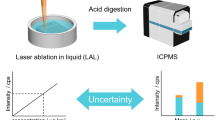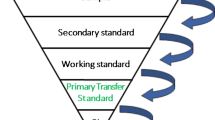Abstract
The members of the committee NMP 264 “Chemical analysis of non-oxidic raw and basic materials” of the German Standards Institute (DIN) have organized two interlaboratory comparisons for multielement determination of trace elements in silicon carbide (SiC) powders via direct solid sampling methods. One of the interlaboratory comparisons was based on the application of inductively coupled plasma optical emission spectrometry with electrothermal vaporization (ETV ICP OES), and the other on the application of optical emission spectrometry with direct current arc (DC arc OES). The interlaboratory comparisons were organized and performed in the framework of the development of two standards related to “the determination of mass fractions of metallic impurities in powders and grain sizes of ceramic raw and basic materials” by both methods. SiC powders were used as typical examples of this category of material. The aim of the interlaboratory comparisons was to determine the repeatability and reproducibility of both analytical methods to be standardized. This was an important contribution to the practical applicability of both draft standards. Eight laboratories participated in the interlaboratory comparison with ETV ICP OES and nine in the interlaboratory comparison with DC arc OES. Ten analytes were investigated by ETV ICP OES and eleven by DC arc OES. Six different SiC powders were used for the calibration. The mass fractions of their relevant trace elements were determined after wet chemical digestion. All participants followed the analytical requirements described in the draft standards. In the calculation process, three of the calibration materials were used successively as analytical samples. This was managed in the following manner: the material that had just been used as the analytical sample was excluded from the calibration, so the five other materials were used to establish the calibration plot. The results from the interlaboratory comparisons were summarized and used to determine the repeatability and the reproducibility (expressed as standard deviations) of both methods. The calculation was carried out according to the related standard. The results are specified and discussed in this paper, as are the optimized analytical conditions determined and used by the authors of this paper. For both methods, the repeatability relative standard deviations were <25%, usually ~10%, and the reproducibility relative standard deviations were <35%, usually ~15%. These results were regarded as satifactory for both methods intended for rapid analysis of materials for which decomposition is difficult and time-consuming. Also described are some results from an interlaboratory comparison used to certify one of the materials that had been previously used for validation in both interlaboratory comparisons. Thirty laboratories (from eight countries) participated in this interlaboratory comparison for certification. As examples, accepted results are shown from laboratories that used ETV ICP OES or DC arc OES and had performed calibrations by using solutions or oxides, respectively. The certified mass fractions of the certified reference materials were also compared with the mass fractions determined in the interlaboratory comparisons performed within the framework of method standardization. Good agreement was found for most of the analytes.











Similar content being viewed by others
References
Schwetz KA (2000) Silicon carbide-based hard materials. In: Ralf Riedel (eds) Handbook of ceramic hard materials, vol 2. Wiley-VCH, Weinheim, pp 683–748
Kirkbright GF, Snook RD (1979) Anal Chem 51:1938–1941
Nickel H, Zadgorska Z, Wolff G (1993) Spectrochim Acta 48B 1:25–38
Golloch A, Haveresch-Kock M, Plantikow-Voßgätter F (1995) Spectrochim Acta 50B(4–7):501–516
Nickel H, Zadgorska Z (1995) Spectrochim Acta 50B(4–7):527–35
Záray G, Kántor T, Wolff G, Zadgorska Z, Nickel H (1992) Microchim Acta 107:345–358
Záray G, Leis F, Kántor T, Hassler J, Tölg G (1993) Fresen J Anal Chem 346:1042–1046
Hassler J, Detcheva A, Förster O, Perzl PR, Flórian K (1999) Ann Chim 89:827–836
Schäffer U, Krivan V (1999) Anal Chem 71:849–854
Peng TY, Sheng X, Hu B, Jiang ZC (2000) Analyst 125:2089–2093
Schrön W, Liebmann A, Nimmerfall G (2000) Fresen J Anal Chem 366:79–88
Peng TY, Chang G, Sheng XH, Jiang ZC, Hu B (2001) Anal Chim Acta 433:255–262
Barth P, Krivan V (1994) J Anal Atom Spectrom 9:773–777
Barth P, Hauptkorn S, Krivan V (1997) J Anal Atom Spectrom 12:1351–1358
Flórián K, Nickel H, Zadgorska Z (1993) Fresen J Anal Chem 345:445–450
Flórián K, Fischer W, Nickel H (1994) Fresen J Anal Chem 349:174–175
Flórián K, Hassler J, Schrön W (1996) Fresen J Anal Chem 355:601–605
Flórián K, Hassler J, Surová E (1999) J Anal Atom Spectrom 14:559–564
Flórián K, Hassler J, Förster O (2001) Fresen J Anal Chem 371:1047–1051
Matschat R, Dette A (2004) Final certification report: BAM-S003. BAM, Berlin (see http://www.bam.de/pdf/service/referenzmaterialien/zertifikate/special_materials/bam_s003report.pdf)
Ren JN, Salin ED (1994) Spectrochim Acta 49B:555–566
DIN (1994) DIN ISO 5725–2. Accuracy of measurement methods and results- Part 2: basic method for the determination of repeatability and reproducibility of a standard measurement method. Deutsches Institut für Normung, Berlin
Acknowledgements
The authors are grateful to the German Federal Ministry of Economics and Labour (BMWA) for supporting this project in the framework of the support program “Leistungssteigerung der technisch-ökonomischen Infrastruktur zu Gunsten der deutschen Wirtschaft”. The authors are also most obliged to all participants in the interlaboratory comparisons for validation and standardization of ETV ICP OES and DC arc OES, as applied to silicon carbide powders, and in the interlaboratory comparison for certification of silicon carbide powder BAM-S003.
Author information
Authors and Affiliations
Corresponding author
Rights and permissions
About this article
Cite this article
Matschat, R., Haßler, J., Traub, H. et al. Multielement trace determination in SiC powders: assessment of interlaboratory comparisons aimed at the validation and standardization of analytical procedures with direct solid sampling based on ETV ICP OES and DC arc OES. Anal Bioanal Chem 383, 1060–1074 (2005). https://doi.org/10.1007/s00216-005-3415-x
Received:
Revised:
Accepted:
Published:
Issue Date:
DOI: https://doi.org/10.1007/s00216-005-3415-x




